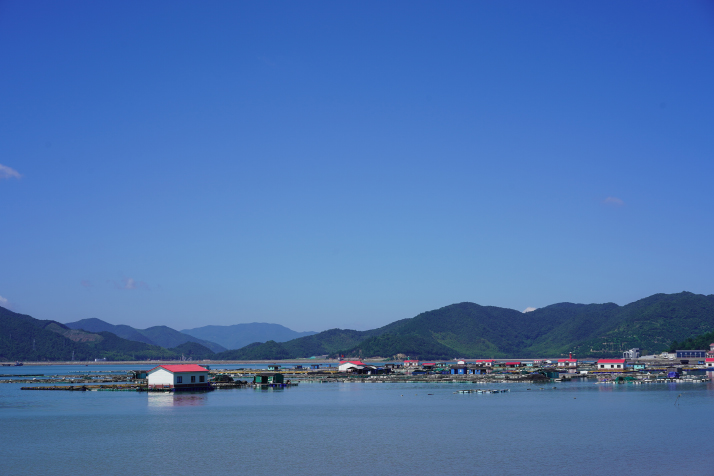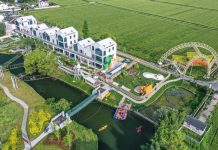
Zhejiang, with its big fishing and shipping industries, is now adjusting its maritime strategy—shifting from “living off the sea” to “prospering with the sea wisely.”
This transformation, to pursue high-quality development, weaves together innovation, sustainability and resilience: upgrading infrastructure to be smarter and greener, tapping into the ocean’s clean energy potential, taming its wrath into resources, and healing its damage from pollution.
Cleaner and smarter port
At the heart of this maritime renaissance lies the transformation of its gateways to the world. Ports, once bustling hubs of labor-intensive activity, are now testaments to how technology can reimagine efficiency and sustainability. Meishan Port Area, a key part of Ningbo-Zhoushan Port, exemplifies this leap.
Ningbo-Zhoushan Port is the world’s largest port in terms of cargo throughput. In recent years, it has emerged as a pioneer in smart and low-carbon port development.
Meidong Co., which operates the port, has built five wind turbines with a total capacity of 31.25 megawatts (MW), generating 57.56 million kilowatt hours (kwh) of electricity annually. It has also constructed a distributed photovoltaic power station producing 1.62 million kwh of electricity per year. Complementary energy storage equipment has also been installed.
Among its innovations is an in-house developed dual-core dispatch system, enabling efficient, autonomous and predictive management. The port area also operates the world’s largest fleet of automated terminal equipment, including 36 remote-controlled quay cranes, 116 yard cranes, and 102 intelligent container trucks, according to Peng Jie, Vice President of the company.
Committed to sustainability, the port area derives 76.5 percent of its total energy from renewable sources. Since 2021, it has cut carbon emissions by 24 percent per 10,000 TEUs. One TEU is equal to the capacity of a 20-foot standard container. The port has electrified all of its major equipment and is expanding the use of liquefied natural gas and electric vehicles throughout its operations.

Homegrown innovation
While ports reduce their carbon footprint, Zhejiang is also looking to the sea itself as a source of clean power. Beyond moving goods, the ocean’s untapped energy—constant, renewable and vast—has become a new frontier for homegrown innovation.
In the ocean close to Zhoushan, an archipelago-based city on Zhejiang’s north coast, stands the LHD Tidal Current Power Station—a global pioneer that’s literally been making waves in clean energy. Since its first unit was connected to the national grid in 2016, this trailblazing project has never stopped pushing boundaries.
The station was developed by Zhejiang Zhoushan LHD Energy Development Co. Ltd. As of July 2024, it had been running non-stop for over eight years, feeding more than 8.61 million kwh of electricity into the grid. It still holds the world record for single-unit capacity and operational duration. Its latest 1.6-MW “Fenjinhao” (“Endeavor”), the world’s largest single-unit tidal current generator, went online in April 2024, making it into the International Energy Agency’s list of the 20 Global Marine Energy Highlights for that year.
Plans are underway for a 100-MW project in Zhoushan. If successful, the team will develop a fifth-generation unit for the “Kuroshio” area in the East China Sea, where abundant tidal energy could bring costs down to below 0.3 yuan ($0.04) per kwh. This isn’t just a power station—it’s proof of how homegrown innovation is unlocking the ocean’s potential.
“China has developed technology for harnessing marine tidal current energy independently from scratch,” Lin Dong, chief engineer at the Zhejiang LHD Marine Tidal Energy Engineering Research Center, told Beijing Review. Lin said he has been advocating the introduction of supportive electricity pricing policies for tidal current energy to inject impetus into the development of the industry.

Woes to wins
Harnessing the sea’s power requires not only innovation, but also harmony with nature. For centuries, coastal communities in Zhejiang have weathered the ocean’s fury, from typhoons to coastal flooding. Today, the province is turning that age-old struggle into a model of coexistence by developing infrastructure.
One water project of Dinghai District of Zhoushan is turning typhoon woes into wins. For years, Dinghai, a coastal enclave hemmed in by mountains, lived under the shadow of typhoons. The storms, funneling rain into its narrow terrain, brought devastating floods—none more searing than Typhoon Mitag in 2019, which caused 1.1 billion yuan ($153 million) in damage.
Today, the danger of these events is diminishing, thanks to the Wushan (Five Mountains) Water Conservancy Project. A feat of pragmatic engineering, the project has reimagined how the city interacts with water.
The project’s four-pronged approach is deceptively simple: 18.3 km of upstream channels intercept 70 percent of mountain runoff before it reaches the city; a 2.6-km tunnel reroutes excess floodwater between reservoirs; three new pump stations boost drainage capacity by 80 percent; and 41.8 km of revamped pipes, including upgrades to aging neighborhood networks, keep urban water flowing.
But the most striking trick up the project’s sleeve is turning disasters into resources. By capturing and treating floodwater, the project now supplies 5.3 million cubic meters of fresh water annually—enough to meet Dinghai’s needs for 2.5 months, a critical boon for a water-scarce island region.
It has also managed to strike the tricky balance between big infrastructure and community trust. Planners solicited public input early; construction crews adjusted plans to save trees, with environmental experts monitoring every step. When work was completed, former construction roads were repurposed into the East China Sea Cloud Corridor, a leafy public trail, and the excavated soil was reused to build community plazas, an innovation that earned a national water conservation award.
With an 890-million-yuan ($124 million) price tag—30 percent funded by the provincial government and 70 percent by the local government—the project has proved its worth. It has held off subsequent typhoons, and during a 110-mm downpour in 2023, Dinghai remained free from flooding. The Cloud Corridor, meanwhile, has drawn crowds since opening that year, breathing new life into the district.
In a region long at the mercy of Mother Nature, it’s a constant reminder: Smart infrastructure doesn’t just defend against water; it can make it work.

From mud to gold
Between taming the sea’s fury and restoring its health, Zhejiang also knows how to nurture its bounty. Coastal communities are turning the ocean’s natural gifts—mudflats, algae, and fish—into sustainable wealth, proving prosperity and ecology can grow hand in hand.
In Huangbiao’ao Township, Xiangshan County, Ningbo, Zhejiang, muddy shores and algae are driving a green revolution. The village of Gaoni, crowned “Zhejiang’s No. 1 Yellow Croaker Farming Village,” has transformed coastal challenges into prosperity.
Through 30 years of innovation, farmers overcame
the hurdle of winter migration by breeding the cold-resistant Daiqu large yellow croaker, ending a long-standing reliance on distant waters. The farmers established a national-level breeding center in collaboration with 16 research institutes, and eco-friendly typhoon-resistant cages boosted fish survival rate by 15 percent.
Unified branding and the “three-rights separation” reform that clarifies ownership, contract, and management rights now secure an annual output of 140 million yuan ($19 million) and provide steady income to the village. Today, 00 acres of farmland support a full industry chain, integrating aquaculture with tourism.
Meanwhile, the “Three Treasures of Xihu Port”—sea lettuce (from the genus Ulva), laver and kelp—anchor a pioneering blue carbon economy. Zhu Wenrong, an entrepreneur with expertise in sea lettuce research, leads Xiangshan Xuwen Seaweed, a company that tops China’s sea lettuce production with a 75-percent domestic share.
The seaweed cleans seawater by absorbing nitrogen and phosphorus while sequestering carbon dioxide. In 2023, Xiangshan County auctioned off China’s first blue carbon credits (2,340 tons), channeling funds into marine conservation and tech upgrades. A new platform that integrates algae and bivalve carbon resources is now in the making; it will create “eco-accounts” to reward fishermen for sustainable practices.

Treating waste
Capturing resources is only part of the equation, while keeping the sea healthy is equally vital. As development accelerates, so does the need to heal the damage inflicted by human activities, particularly the plastic waste that threatens marine ecosystems. Zhejiang’s answer is a circular approach that turns pollution into prosperity.
“To many, marine debris is just waste, but for those of us in the renewable resources industry, it is a treasure,” He Qiqi, CEO of Taizhou Qiju Renewable Resources Co. Ltd., told Beijing Review. Currently, the company processes 60,000 tons of plastic waste annually, including 20,000 tons of marine plastic waste such as fishing nets and crab nets.
Also in this industry is Vision Blue, a company founded in 2017 in Zhejiang’s Taizhou City that launched Blue Circle, an innovative and impactful program dedicated to addressing marine plastic pollution. This initiative is redefining approaches to tackling marine plastic waste through a comprehensive, sustainable framework.
The program operates under a robust governance model integrating government guidance, enterprise leadership and public participation. Fishermen, once viewed as part of the pollution challenge, have transformed into “coastal guardians.” Through the program, the value of the plastic waste they collect has increased sevenfold compared to previous rates, helping them generate additional income.
By leveraging advanced technologies like the Internet of Things and blockchain, Blue Circle ensures full traceability of marine plastic throughout its entire life cycle, from its ocean origin to processing into end products. Combined with international certification, this traceability boosts the value of marine plastic waste, effectively turning what was once trash into valuable resources used to produce daily necessities such as umbrellas, bags, scarves, and car parts.
Taizhou has introduced China’s first local regulation on marine plastic waste, set to take effect this October. Blue Circle now encompasses 15 marine plastic waste collection points, five accredited processing factories, a digital platform that both traces and supports the entire process, and an exhibition center to drive public participation. To date, the city has processed 54,500 tons of plastic waste, offering a replicable model for sustainable marine plastic pollution control both domestically and internationally.
From ports that run on solar power and wind to fishermen-turned ocean guardians, Zhejiang’s blueprint isn’t just about development—it’s about rethinking humanity’s relationship with the sea. In balancing growth and care, it sheds light on how the world can thrive with the ocean, not at its expense. –The Daily Mail-Beijing Review news exchange item





